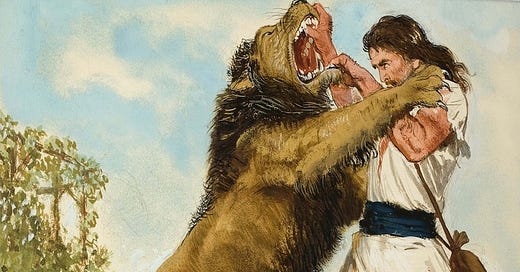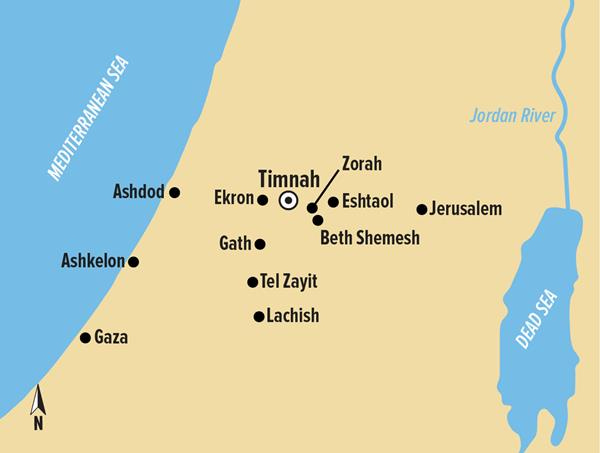This is part fourteen of my Judges study. Read the previous parts here and watch for part fifteen coming on February 19.
This chapter begins by recounting a trip Samson took to Timnah. Identified with modern Tel el-Batash, Timnah was a Philistine city in the Shephelah that also features in the story of Judah and Tamar.1 There, he saw a young Philistine woman and told his parents to arrange a marriage between them. His parents were not impressed and asked why he could not take an Israelite wife. Undeterred, Samson demanded that they get for him, insisting that she was the right woman for him to marry, or more literally, that she was right in his eyes, echoing the motto of Judges.2
This interaction demonstrates Samson’s poor judgement and the fact that he is motivated by what feels good at the moment instead of thinking logically about the implications of his actions.3 Furthermore, Samson lacked the proper respect for authority figures, especially his parents. It may seem odd to modern people that Samson’s choice of a bride created such a stir in his family, but in a culture that expected parents to arrange marriages for their children and frowned upon marriages to someone from another nation, especially Philistines, this was a big deal and certainly paints Samson in a negative light. His marriage to a Philistine woman also contrasts4 Othniel’s marriage to Achsah in chapter 1, as Othniel was a foreigner who became an Israelite and Samson, who was born an Israelite, became part of Philistia.
On his way to Timnah's vineyards with his parents, Samson encountered a lion, which he then killed with his bare hands, though he did not tell his parents. Other characters such as Gilgamesh and Heracles in ancient hero stories were said to have defeated lions with their bare hands, so this was a common trope in these narratives.5 Although lions no longer reside in this area, a type of lion, known as the Asiatic lion, lived throughout the Levant and Mesopotamia in ancient times.6
The reason for Samson’s secrecy regarding the lion and its honey becomes apparent when one realizes that this violated the Nazirite vow and would require him to undergo a ritual at the Tabernacle. He would have had to shave his head, offer two turtledoves or pigeons for a sin and burnt offering, rededicate himself as a Nazirite, and give a one-year-old male lamb for a guilt offering (Numbers 6:9-12). However, Samson selfishly did not want to deal with all that and so kept to himself what he had done.
Later on, when Samson went to marry the woman, he found the lion carcass off the side of the road with a swarm of bees making honey inside it. Scooping out some of the honey, he ate it and shared it with his parents, not telling them where it had come from. His seeing and eating of the honey is a possible allusion to Eve eating the forbidden fruit in Genesis 3.7 Once again, Samson showed a clear disregard for the laws concerning ritual purity despite his special status as a Nazirite, as both touching the dead lion and eating the honey from it were considered unclean.8 While his father went to meet with the woman, Samson prepared a feast. The wedding feast would have involved drinking wine, as was customary in the ancient Near East, and though the text does not specify, Samson probably partook of the wine, breaking his Nazirite vow once more.9
Samson offered to give thirty linen garments and changes of clothes to a group of thirty Philistine men if they could solve his riddle within the seven days of the feast, and that they would have to give him that amount of clothing if they could not answer it. He had to have been very confident that they would not have guessed his riddle given that clothing was extremely valuable before industrialization arose, as it took much longer to produce. The men agreed, and Samson gave his riddle as follows: “Out of the eater came something to eat, and out of the strong came something sweet.”
None of them could answer it, and on the fourth or seventh day, as there is a textual variant here, the Philistine men told Samson’s wife to find out the answer to the riddle. The Septuagint and Syriac versions say “fourth,” whereas the Masoretic Text, Aramaic Targum, and Latin Vulgate all read “seventh.”10 Otherwise, she and her father’s family would all be burned alive. They then asked, “Did you invite us here to rob us?”
In great distress, the wife begged Samson to explain the riddle but he said that he did not want to tell her as he had not even told his parents. Samson’s wife wept for the rest of the feast, so Samson gave in and told her the answer.
At the end of the seventh day, the men of the city said to Samson, “What is sweeter than honey? What is stronger than a lion?”
In response, he said, “If you hadn’t plowed with my young cow, you wouldn’t know my riddle now!” which was essentially a creative way of calling them a bunch of cheaters. The Spirit of the Lord came upon Samson and he slaughtered thirty Philistines at Ashkelon, taking their clothes to give to the men who had answered his riddle. Situated on the Mediterranean coast, Ashkelon was one of the cities of the Philistine pentapolis and was located 37 km (23 mi) away from Timnah.11 Full of rage, he went back to his father’s house and his wife was given to another man.
This episode is the first look at Samson’s adult life and does not portray him positively. Quite the opposite, he is shown to be an “immature, incensed, out-of-control youth.”12 Samson was solely focused on fulfilling his desires for women, feasting, and revenge, making him a person no one should strive to emulate. As the story progresses, we will see more of what makes Samson the worst judge.
BIBLIOGRAPHY
Block, Daniel I. “Judges.” In Joshua, Judges & Ruth, edited by John H. Walton, 198-451. Zondervan Illustrated Bible Backgrounds Commentary Series. Grand Rapids, MI: Zondervan, 2009.
Boda, Mark J. “Judges.” In Judges, Ruth, edited by Tremper Longman III and David E. Garland, 30-347. The Expositor’s Bible Commentary Series. Grand Rapids, MI: Zondervan, 2012.
Evans, Mary J. Judges and Ruth. Tyndale Old Testament Commentaries Series. Downers Grove, IL: InterVarsity Press, 2017.
McCann, J. Clinton. Judges. Interpretation: A Bible Commentary for Preaching and Teaching Series. Louisville, KY: John Knox Press, 2011.
Way, Kenneth C. Judges and Ruth. Teach the Text Commentary Series. Grand Rapids, MI: Baker Books, 2016.
Webb, Barry G. The Book of Judges. The New International Commentary on the Old Testament Series. Grand Rapids, MI: William B. Eerdmans Publishing Company, 2012.
Younger Jr., K. Lawson. Judges and Ruth. The NIV Application Commentary Series. Grand Rapids, MI: Zondervan, 2002.
Block, “Judges,” 345.
McCann, Judges, 111.
Younger, Judges and Ruth, 289.
Way, Judges and Ruth, 179.
Way, Judges and Ruth, 180.
Block, “Judges,” 347.
Evans, Judges and Ruth, 143.
Boda, “Judges,” 256.
Younger, Judges and Ruth, 293.
Boda, “Judges,” 260.
Way, Judges and Ruth, 182.
Webb, The Book of Judges, 379.








He's a hot mess from start to finish.
I think Samson is very interesting but definitely an immature man!